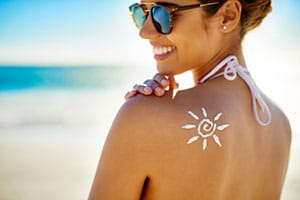SUNSCREEN: CHEMICAL VS. PHYSICAL SUNSCREEN
- Posted on: Oct 23 2017

The sun’s harmful rays are just as strong and damaging despite what your thermometer says — particularly the UVA rays which are responsible for aging skin. There are two types of UV rays that breach the ozone layer and cause damage to the skin: UVA rays and UVB rays. UVA rays penetrate the layers of the skin, causing most premature aging. UVB rays cause tanning and burning on the upper layers of the skin. Both UVA and UVB rays are linked with skin cancer and long-term harm for your health.
Broad spectrum sunscreens protect us from UVA rays, the aging rays of the sun, and therefore they can honestly claim to “aid in the prevention of premature aging.
With our current knowledge of the potentially damaging effects of UV rays, it should be unthinkable to leave the skin exposed to the elements. Wearing a sunscreen whenever exposed to daylight is just a small way that we can boost our body’s defense against the ravages of UV radiation.
Consider physical sunscreen (as opposed to chemical sunscreen).
Physical sunscreens use UV filters that reflect, scatter and block the sun’s rays. Chemical sunscreens use active ingredients that absorb UV radiation, preventing them from penetrating the skin. Over time, some chemical filters slowly break down and release heat. While all physical UV filters block from both UVA and UVB rays, most chemical UV filters protect one or the other, not both.
Physical sunscreens provide better broad-spectrum coverage as compared to chemical-based sunscreens which are usually either UVB or UVA blockers. Physical sunscreens deflect or block the sun’s rays, whereas chemical sunscreens absorb the sun’s rays. Additionally, physical blockers work for a longer period of time giving longer coverage, requiring less re-application. They are also less irritating than chemical blockers. While physical sunblock — which contains zinc oxide and titanium dioxide — may be messier to apply, it offers the best year-round protection.
Ultraviolet rays can also cause hyperpigmentation (year round), so wearing sun protection can dramatically reduce the incidence of skin discoloration. Ideally, the product will be fragrance-free, as this prevents photo-aging from
chemical exposure. The sunscreens are also used to counteract the negative photo-aging effects of free radicals (from daylight) on the skin.
Think about choosing a sun protection product that also contains a good dose of antioxidants to fight those very nasty free radicals that age our skin. As manufacturers respond to recent research, you’ll notice that the latest products being released in the sun protection category are being formulated with powerful antioxidants.
CONCLUSION
It’s important to remember that sunscreen is an excellent addition to your everyday skincare ritual—even on overcast and cold days because the sun’s rays are still present. Don’t forget to apply enough sunscreen to cover all exposed areas, especially those often overlooked such as the back of the neck, ears, neck and décolleté, which are particularly susceptible to sun damage. Keeping track of your sun exposure, and reapplying sunscreen as often as needed depending on how long you are outdoors, is your first line of defense against UV radiation.
Visit our Products Page for more information.
Posted in: Uncategorized




